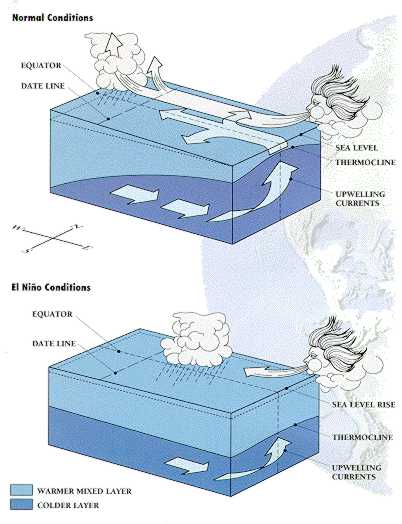| In
the context of climate and weather, the name El Niño originally
referred to the warm ocean current that appears along the pacific coast
of South America each year around Christmas. In Spanish, El Niño
means "the boy", a reference to the Christ child, since historically the
phenomenon has been observed near Christmas. Recently however, the term
has been applied to those years when there is a change in this annual pattern. |
In the equatorial Pacific
Ocean, the wind usually blows from east to west, dragging the surface water
along. Because of Earth's rotation, the eastward-flowing water is deflected
to the north in the Northern Hemisphere and to the south in the Southern
Hemisphere.This creates a surface divergence along the equator that is
filled by cold, nutrient-rich water moving up from below (upwelling), forming
a cold tongue in the eastern Pacific. As the warmer surface water is moved
westward by wind, the thermocline (a zone in the water column that shows
a sudden change in temperature with depth) separating the surface water
from the colder water is raised in the east and depressed in the west.
The easterly wind converges over the resulting warm water in the western
Pacific, picks up large amounts of moisture, and ascends through the atmosphere
by a process known as deep convection. Dry air subsides above the cold
tongue and forms the Walker Circulation along the equator.
|
 |
In
an El Niño year, the easterly wind weakens and the equatorial upwelling
is suppressed. The thermocline "flattens"and warm surface water surges
eastward. The nutrient supply from the cold, deeper water is not tapped. |
| The easterly
wind retreats and the westerly wind pushes the convection process to the
East of the international date line (a jagged arbitrary line where a date
change occurs). This displacement of the convection causes a change in
traditional rainfall patterns and the release of large amounts of latent
heat into the atmosphere. The subsequent energy propagates within the atmosphere,
affecting the weather in various ways and places and disrupting the normal
rhythm of life across the Pacific Ocean. The ability to accurately predict
El Niño would be of great benefit to countries around the world. |
